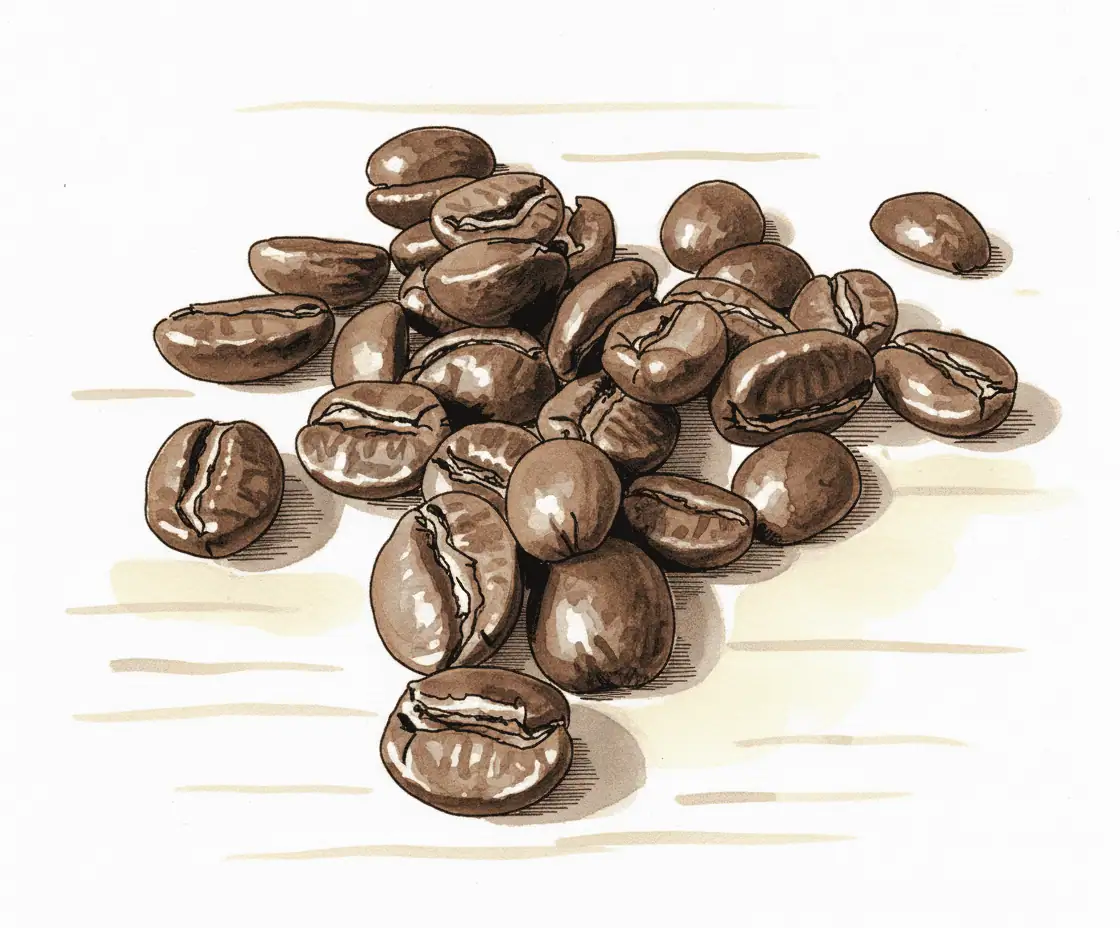Average altitude
Mid altitudes (around 1200–1500 meters) produce beans that offer a balance between sweetness and acidity. Growing conditions are still mild, yet the beans often develop more refinement than at lower elevations. This results in a brighter flavor profile, sometimes with subtle fruit or floral notes. Mid-altitude regions are common in countries such as Colombia, Mexico, and parts of Central America.
Beans

Cafeïne vrij
Deze cafeïnevrije koffie van Zwarte Koffie komt van de biologische boerderij Aquiares in Costa Rica en wordt via direct trade eerlijk ingekocht. De bonen zijn natuurlijk gedecafeïneerd zonder chemicaliën en donker gebrand voor een stevige body. Verwacht smaken van donkere chocolade en karamel met een aangename bite, ideaal voor espresso, filter en melkkoffies. Klanten waarderen…

Cameroon – More than fair – Kumbo
Deze medium roast uit Kumbo, Kameroen, komt van de coöperatie Hilltop Farmers binnen het Circle of Excellence programma. Dankzij directe handel met Matti Foncha ontvangen boeren een more than fair prijs en ondersteuning bij wasstations. Branderij Luijendijk brandt herkomstgericht, geschikt voor espresso en filter. Verwacht romige melkchocolade, noten en tonen van gedroogd fruit, met een…

Cappuccino Melange
Deze krachtige espresso blend combineert 100 procent Arabica uit Brazilië, Costa Rica, Guatemala en Ethiopië. De medium tot licht donkere branding geeft een volle smaak met tonen van bittere chocolade, cacao, vanille en een bloemig fruitig accent. Door de mix van natuurlijke en gewassen verwerkingen blijft het profiel helder en gebalanceerd. Ideaal voor espresso, cappuccino,…

Capricornio Pioneiro, Brazil
Capricornio Pioneiro comes from the south of São Paulo and Paraná, where a cooler climate along the Tropic of Cancer slows down ripening and produces larger cherries. The network of farmers works with relationship blends and restores historical coffee areas. The roast is medium-light, suitable for espresso and fully automatic machines, but also works as a filter coffee via V60...

Chiapas
Engrano Chiapas komt uit de staat Chiapas in zuidelijk Mexico, waar koffie groeit op vulkanische bodem in de Reserva El Triunfo op 1200 tot 1800 meter. De bonen zijn 100 procent Arabica met variëteiten Mundo Novo en Bourbon, gewassen verwerkt voor een schone, complexe kop. De lichte branding benadrukt een medium body met proefnotities van…

Chiapas, Mexico
Deze Chiapas koffie komt uit Amatenango de la Frontera in Chiapas Mexico en is geproduceerd door Luis Ordonez. Het profiel is medium gebrand met een balans van zoet en fruitig. Verwacht tonen van chocolade, noten, appelcider en sinaasappel. De koffie is gewassen verwerkt, wat zorgt voor helderheid en een schone afdronk. Variëteiten Garnica en Bourbon…

City Limits
City Limits is een espresso blend met 70 procent Brazilië Inacio Soares F2 en 30 procent El Salvador Rodolfo Ruffati Red Bourbon. De bonen groeien tussen 880 en 1650 meter en worden verwerkt met honey en gewassen methodes voor een balans tussen zoetheid en helderheid. De medium tot medium donkere roast benadrukt tonen van donkere…

Coatepec
Deze single origin Coatepec koffie uit Veracruz komt van Garnica Arabica, geteeld rond 1250 meter. De lichte branding benadrukt een milde body, frisse tonen van groene appel en een lichte zoete nasmaak die aan ahornsiroop doet denken. De gewassen verwerking houdt het profiel helder en gebalanceerd, ideaal voor filtermethodes zoals pour over. Engrano werkt met…

Colombia
Op Kop Colombia is een medium roast met een helder, fruitig profiel. De bonen komen uit regio’s als Huila, Antioquia en Tolima en worden gewassen verwerkt voor een zuivere, frisse smaak. Verwacht tonen van amandel, kers, chocolade en karamel, ondersteund door een medium body en milde zuurgraad. Geschikt voor espresso, filter, French press en percolator,…

Colombia Excelso
Colombia Excelso van Miss Morrison komt van Finca Casagrande in Turuel Huila op 1500 tot 1700 meter. De koffie is medium roast met een evenwichtige body en aciditeit, en geeft smaken van chocolade, kers, noot en karamel. Dankzij de gewassen verwerking is de smaak schoon en helder. De screenmaat Excelso 15 tot 17 zorgt voor…

Colombia Huila cafeïnevrij
Colombia Huila cafeïnevrij komt uit het zuidwesten van Colombia op circa 1500 meter. De arabica wordt in het herkomstland gedecafeïneerd via het suikerriet EA proces, zonder extreme hitte en met behoud van aroma en structuur. De koffie behaalde een SCA score van 87,5 en biedt een gebalanceerd profiel met tonen van rood fruit, vanille en…

Costa Rica | El Cerco
El Cerco is a specialty microlot from Costa Rica's West Valley at 1,400 metres, run by Cristobal Matamoros. Ikigai's light to medium roast is tailored for filter and showcases fruity sweetness, cinnamon and apple pie aromas. The beans are Caturra and Catuai and were processed with the anaerobic honey process, in which…

Costa Rica Coope Tarrazu
Dankzij de hoge ligging in Tarrazu, Costa Rica rijpen de bessen langzaam, wat zorgt voor een zuivere kop. Deze medium roast is dagelijks vers gebrand en scoort als Strictly Hard Beans. Verwacht een notig aroma met smaken van pure chocolade en honing, mooi in balans en met nauwelijks zuurgraad. De bonen worden volgens het washed…

Costa Rica Pura Vida
Deze Costa Rica Pura Vida koffie komt uit Tarrazu, waar hoogtes tot 2000 meter zorgen voor compacte bonen en rijke aroma’s. CoffeeXperts brandt wekelijks medium tot donker voor een volle, gebalanceerde kop met tonen van noten, pure chocolade, zwarte thee, citroen en suikersiroop. De bonen zijn gewassen verwerkt, wat helderheid en zuiverheid benadrukt. Variëteiten Caturra…

Cuba
Deze Cuba koffie van De Pelikaan is 100 procent Arabica met een medium branding en sterkte 3. Verwacht een rijk, geurig profiel met noot en chocolade, een evenwichtige body en een aanhoudende nasmaak. De koffie komt vooral uit de Sierra Maestra en wordt via Cubaexport verhandeld. Verkrijgbaar als bonen of gemalen voor filter, espresso en…
Mid-Altitudes (around 1200–1500 meters)
Looking for a beautiful balance between sweetness and acidity in the cup? Then beans from mid-altitude regions are a great choice. These areas are common in countries like Colombia, Mexico, and parts of Central America. Here you get the best of both worlds: enough coolness for a refined taste, yet enough warmth for good sugar development.
How altitude affects espresso flavor
At elevations of roughly 1200 to 1500 meters, coffee cherries still ripen more slowly than at sea level, but not as slowly as at very high altitudes. This creates a balanced espresso: a mildly sweet base, often with subtle fruity or floral hints, alongside a pleasant, not overly dominant acidity. These coffees are known for their approachable yet refined character. They are often ideal for those who enjoy an espresso with a clear flavor, but without the sometimes “sharp” edge of very high-grown beans.
Chemical composition: balance of sugars and acids
Mid altitudes still give the coffee plant enough coolness to build complexity, yet enough warmth to encourage sweeter notes. The beans generally have a slightly lower density than true high-grown beans, but remain firm enough to develop a wide flavor palette. You will notice the acids are a touch less pronounced, allowing the sweetness to come forward. This can yield a balanced cup of espresso with both freshness and a soft body.
Processing methods: diversity is key
In many regions at these elevations, there is active experimentation with different processing methods. The washed method remains popular, but honey and semi-washed processes are also often used, depending on local traditions and the desired flavor profiles. Thanks to slightly higher temperatures (compared to high mountains), sun-drying beans is often easier. This allows farmers to apply natural or pulped natural methods, which in turn leads to more sweetness and sometimes a hint of fermentation in the taste.
Climate and microclimate
At 1,200 to 1,500 meters, conditions usually mean mild temperatures, regular rainfall, and still plenty of sun. This kind of environment is ideal for coffee shrubs. They are protected from extreme heat, but also from the cold of great heights. As a result, the growing season is stable and fairly predictable. Microclimates arise from local variations in rainfall and hours of sunshine. A shrub on one mountainside can therefore produce slightly different flavor nuances than one on the slope next to it.
Yield and resilience
In general, the yield here is better than at very high elevations, because the plants are less stressed by colder nights or thin air. This means farmers can often produce slightly higher volumes while quality remains high. Moreover, the shrubs can often stay healthy for longer, provided they are well maintained. A stable yield is beneficial for the local community, as farmers’ income is less dependent on erratic harvests.
Choosing coffee varieties
In this altitude band, many Arabica varieties are found, such as Caturra, Colombia, and Bourbon. Farmers often choose plants that strike a good balance between yield and flavor. Some varieties are resistant to diseases like "coffee leaf rust", which is an important factor in areas with higher humidity. This allows farmers to grow with confidence, knowing they will harvest consistently tasty coffee.
Coffee from mid-altitudes is therefore highly recommended for anyone seeking a balanced espresso. Expect subtle fruit or floral notes, complemented by a mildly sweet body. No sharp extremes, but a rich, approachable flavor that many drinkers appreciate.
A selection for those who are open to a lively and complex coffee experience.
